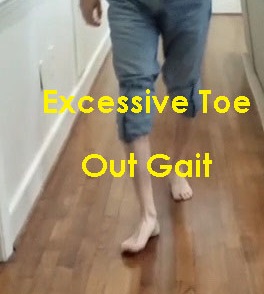Deviant movement resulting in pain – Excessive Toe Out Gait

Asymmetrical movements walking or running are considered deviant or less than optimal movements.
The individual in the video below is complaining of musculoskeletal pain in the left lower extremity.
What do you see?
Do you see the asymmetrical movement? Do you see the right foot is pointing straight ahead, and the left foot is not pointing straight ahead but off to the left? This is called an excessive toe-out gait deviation. The technical term is excessive foot progression angle or angle of foot relative to the line of progression. It is excessive if the angle is greater than 5° to 10° from the line of progression. An easier description is when viewed from behind if more than 2 lateral toes can be viewed the toe out gait is excessive.
The assumption is that walking or running movements are symmetrical movements. Movements on the right side of the body should match movements on the left side of the body. In the video above the toe-out gait is greater on the left compared to the right. Asymmetric movement walking and running is less than optimal or deviant.
What do you think?
What do you wonder and question?
This asymmetrical movement of excessive toe-out gait can be a contributing factor of musculoskeletal pain syndromes of heel pain, knee pain, hip pain, and back pain.
Excessive toe-out gait will often continue to be present despite an osteoarthritic hip or knee joint having undergone replacement surgery. This occurs from long-standing habitual gait deviation related to painful joints and incomplete rehab post-surgery.
Is the observed deviant gait on the left side occurring in response to the pain?
Is the observed gait a contributing factor to the development of musculoskeletal pain syndrome?
Is this gait deviation something, that can be or should be changed?
Is there a structural anatomical variation explaining the asymmetrical movement?
Is the observed gait deviation acquired because of habitual posturing, functional repetitive activities?
These are questions a Physical Therapist can help answer.
Endeavoring to answer these questions determines whether the asymmetrical deviant movement (less than optimal movement) may be the best compensation available. Or whether there is a different compensation to consider.
Preexisting structural variations such as scoliosis, hip dysplasia, club foot deformity, previous traumatic fracture, and previous traumatic joint injury during the period of growth can explain asymmetrical movements. It is unlikely the structure deviations can change. If so, he/she should continue to walk/run with asymmetrical movements. Other interventions are necessary to address the musculoskeletal pain syndrome.
The asymmetrical deviant movement (less than optimal movement) may be an acquired alignment and movement that can be altered. Habitual repetitive daily activities can result in asymmetrical alignments and movements.

The image is from Harris-Hayes, M et.al. JOSPT - 2016
Sitting in the positions above can lead to the development of muscle imbalances in the hip, knee, foot, or all three joints. This is relative flexibility/stiffness, an increased stiffness of one muscle group or joints can lead to compensatory increased movement at adjacent muscle groups or joints that are less stiff. Habitual standing postures can be a contributing factor.
Potential interventions to alter acquired malalignment and movement asymmetry.
Minimize and avoid habitual asymmetrical sitting and standing postures where the foot/leg is pointed outward.
Use strengthening and flexibility exercises. Strengthen muscles that turn the foot/leg inward. Stretch the muscles that turn the foot/leg outward. If the malalignment is from the knee this blog article provides specific examples of potential strengthening and stretching exercises to turn the lower leg inward.
Use gait training to consciously alter the deviant movement seeking for more symmetrical movement. Previous blog articles here, here, here, and here provide more details on how to consciously alter the gait deviation of excessive outward rotation of the leg/foot.
The table below provides potential cues, prompts, and feedback to alter the specific gait deviation of excessive toe-out gait.
| Sensory System | Internal focus of attention: cueing, prompting, feedback |
| Visual | Imagine visualization foot is the front car tire, keep it straight down the road |
| Auditory | Listen to verbal cues from the coach, “yes,” “dampen it,” “need more effort” |
| Kinesthetic/tactile | Push heel outward, or turn toe inward |
| External focus of attention: cueing, prompting, feedback | |
| Visual | Align foot with line on floor, road, and track. Walk through a puddle and turn around to see the alignment of footprints. |
| Auditory | Say out loud “Turn your foot inward” |
| Kinesthetic/tactile | Tap or touch the muscles on the front and side of the hip, and use & engage this muscle to turn the leg inward. |
When walking or running with asymmetrical movement, is the best compensation for a painful musculoskeletal pain syndrome, or should it be altered? Analysis and clinical reasoning can help us find answers.
The information on this website is not intended or implied to be a substitute for professional medical advice, diagnosis, or treatment. You are encouraged to perform additional research regarding any information contained available through this website with other sources and consult with your physician.
Damien Howell Physical Therapy – 804-647-9499 – Fax: 866-879-8591 At-Home, At Office, At Fitness Facility – I come to you, I do home visits Damien@damienhowellpt.com
